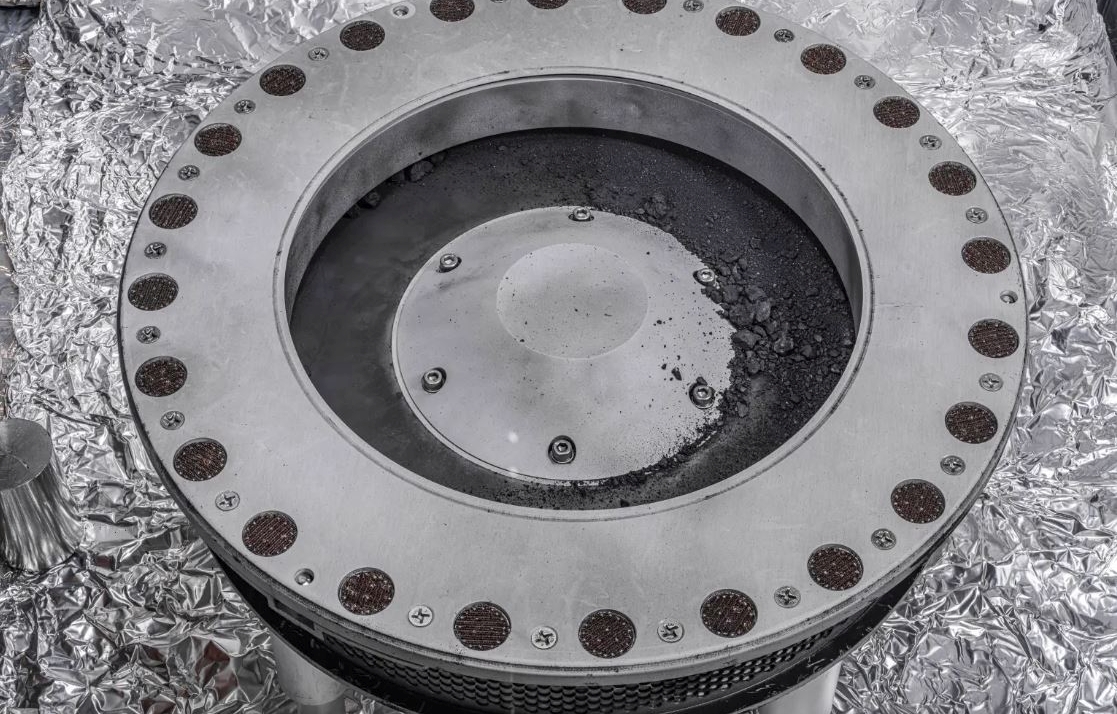
Preliminary analyzes show that precious samples from asteroid Bennu, brought back by NASA’s OSIRIS-Rex mission, contain significant amounts of water and carbon, including organic compounds, providing support that the asteroid’s impacts brought ocean water to Earth and the elements essential for life.
The case containing the bulk of the samples will be carefully opened in the coming weeks, but researchers from NASA and other institutions have had the opportunity to examine an additional amount of dust and gravel trapped inside the capsule containing the case.
After a three-year journey, the OSIRIS-REx spacecraft launched the capsule and parachuted into the Utah desert two weeks ago.
Black dust covered all surfaces when the capsule was opened (NASA)
NASA estimates the inner package contains at least 250 grams of surface material from Bennu, the largest asteroid sample ever brought to Earth — and much larger than the samples Japan returned from two other asteroids in 2010 and 2020.
“It’s days like these that continue to amaze me,” NASA Administrator Bill Nelson said Thursday afternoon when he revealed the first images of the device.
Bennu is thought to be not a solid object, but rather what astronomers call a “mass pile”: an accumulation of dust and rock left over from the formation of the solar system.
Therefore, it serves as a kind of time capsule that may provide new information about the formation process of the Earth and the rest of the planets.
“The OSIRIS-Rex sample is the largest sample from a carbonaceous asteroid ever brought to Earth, and it will help scientists investigate the origins of life on our planet,” Nelson said.
He noted that the new data will also help understand the nature of asteroids that could one day threaten Earth.
Bennu itself is considered a “potential risk,” with NASA estimating a 1 in 1,800 chance of the asteroid hitting Earth sometime in the 22nd century, with the risk peaking on September 24, 2182.
The OSIRIS-Rex capsule parachuted into Utah on September 24. (NASA/Keegan Barber)
Coal and water
Early analyzes included electron microscope images, infrared measurements, X-ray diffraction, CT scans and chemical analyses.
The first important finding is that the samples contain a high carbon content, approaching 5%. Some of this carbon is bound in carbonate compounds, as is the case with some minerals found on Earth, but the sample also contains organic matter that combines carbon and hydrogen.
On Earth, these organic compounds also arise from geological processes, but are most often produced by living organisms.
The second observation is that the sample contains clay minerals in the form of microscopic fibers bound to water, which may have been present since the beginning of the solar system.
According to one prevailing theory, the nascent Earth lacked water, but later gained oceans thanks to water carried by asteroid and comet collisions.
The capsule containing the precious samples was transported to a laboratory at NASA’s Johnson Space Center in Houston, which was set up exclusively for their analysis. The laboratory is located in Building 31, which also houses samples from the Apollo moon missions.
The material is likely to take years to analyze, requiring special treatment to avoid contamination with ground materials.
In the coming months, part of the samples will be sent to 60 laboratories around the world, but 75% of them will be stored under seal for future analysis.
Penny’s diameter is about 500 meters (NASA)
Falling asteroids
NASA is celebrating “asteroid autumn” this year, as in addition to the arrival of the OSIRIS-Rex samples, there will be developments on two other missions.
The Psyche ship is scheduled to launch on October 5 to the asteroid of the same name, which is estimated to contain minerals worth ten million trillion dollars.
A month later, the Lucy mission, which was launched in 2021, will reach its first destination, the asteroid Dinkenish, located in the asteroid belt.
It will then explore the so-called Trojan asteroids, which follow Jupiter on its journey around the sun.

“Total alcohol fanatic. Coffee junkie. Amateur twitter evangelist. Wannabe zombie enthusiast.”





More Stories
Is this what the PS5 Pro will look like? (Image)
Finally, Windows 11 24H2 update significantly boosts AMD Ryzen – Windows 11 performance
Heart Surgeon Reveals The 4 Things He ‘Totally Avoids’ In His Life